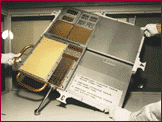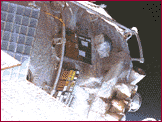



Objectives
The PIE investigation had three main objectives and three tertiary objectives. The main objectives were: (1) to capture micron/submicron dust grains in a manner that insures minimal particle degradation, (2) to return the captured particles to Earth for complete, detailed analysis to determine the grain composition, and (3) to identify the particle remnants of any micron sized extraterrestrial grains to be related with the possible cometary origin of the grains. The tertiary objectives included: (1) the assessment of the level of contamination seen on the returned hardware, (2) to study the effects of UV-radiation on organic molecules in space, and (3) to assess hard radiation environment levels, constituents and effects.
Shuttle-Mir Missions Approach Results
After 327 days on the Mir station, the following preliminary conclusions can be drawn:
· A flux-mass distribution of impacting particles has been derived with reasonable accuracy due to the large time-area exposure. Several intact captured particles have been located and removed.
· The impact data observed at the larger sizes is well above the predicted values. This suggests that: the population density of larger sized particles is greater than believed at these higher altitudes (and by inference, those immediately above them).
· Silicon contamination (as SiOx) was observed on the returned hardware. This has also been observed previously on other hardware returned from Mir.
Earth Benefits
By researching the types of particles, as well as the size and velocity of the particles that have encountered the Space Station Mir, it appears possible to identify ways to protect such objects against hypervelocity impacts in Low Earth Orbit (LEO). This includes laboratory studies to simulate impacts on new materials being considered for both the external structures of the International Space Station and new satellites. Second, it will be possible to verify previous mathematical models on the behavior and production of particles in the space environment. With such information at hand, new, more durable materials can be developed that will help protect spacecraft from possible catastrophic impacts, saving money, as well as lives.
Publications Principal Investigators Co-Investigators![]()
NASA-2 - NASA-4, STS-84
The PIE experiment was delivered to the Mir Space Station during the launch of the Priroda Module from Baikonur Kazakhstan. During an EVA by the Mir-21 crew, the experiment was attached to the exterior of the KVANT-2 Module. PIE remained outside the Mir station, requiring no crewtime during the NASA-2 and NASA-3 missions. During the NASA-4 mission, an EVA was conducted by NASA Astronaut Dr. Jerry Linenger to retrieve the experiment. The experiment was returned for study aboard the STS-84 Space Shuttle mission.
Data analysis is still ongoing. As of the last report, 77 impacts had been observed.
As the global community begins to rely more heavily on digital and electronic communications, Earth-orbiting structures like communications satellites have become increasingly important. These satellites provide pager, telephone, television, military intelligence, and news service around the world. Because of the great expense involved in placing such satellites in orbit, longevity is a necessity. In order to achieve such longevity, ways to enhance the external structure of satellites need to be developed.
None available at this time.
Carl R. Maag, Ph.D.
T&M Engineering
S. P. Deshpande
Michael Meyer
![]()
|
|
Curator:
Julie Oliveaux
Responsible NASA Official: John Uri |
Page last updated: 07/16/1999
.gif)